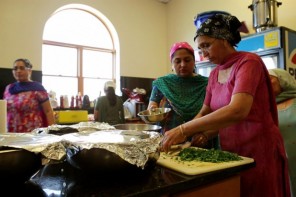By day, PJ Quesada serves as Vice President for his family’s 46-year-old company, Ramar Foods, manufacturers of frozen Asian cuisine (think Orientex and Magnolia Ice Cream). But outside of his family’s business, the 30-year old Quesada has become a fixture in the Fil-Am food scene. In 2012, Quesada founded The Filipino Food Movement, a non-profit committed to awareness and appreciation of Filipino cuisine. Their annual food festival, Savor Filipino, kicked off in 2014 in San Francisco and features some of the best and brightest in Filipino culinary arts.
—Lisa and Irene Yadao
Q: Where did you grow up and how did Filipino food fit into your childhood and adulthood? Have you always been passionate about Filipino food or were you interested in other cuisines?
A: I grew up in the San Francisco Bay Area (East Bay). I always had Filipino food at home, and it wasn’t until I was much older that I went seeking it outside of the home. I was diagnosed with asthma growing up, and one side effect of the medication is weight gain, so during hard days after getting bullied at school I came to rely on my mom’s cooking to help me feel better. While I now eat all cuisines, I used to be rather picky as a child. Anything that wasn’t Filipino food (or chicken McNuggets) just didn’t interest me. My dad used to have a genius method to get me to try new foods. If I was reluctant, he would say, “Just try it. If you don’t like it, I’ll give you a dollar.” I never did get a dollar from that deal!
Q: When or how did you come to realize there was a need for activism, and the work that you do with The Filipino Food Movement.
A: My family is in the food industry. As manufacturers we began asking ourselves what the next generation of customers would need. Our study began with the American-born generation of Filipinos that are now coming into their own adulthood with diverse careers. Some of the things that stood out was that as we asked [them] about their preferences and habits, they were telling us that they wished they had more ways of connecting with their heritage, and they want more Filipino options outside the home. At that point, it became a personal journey for me. It’s partly about bringing awareness to Filipino food and culture for broad audiences, and partly my own journey to discover what it means to be a Filipino American.
Q: How do you feel the movement, and Filipino food, is received by both the Fil-Am community and non-Filipinos?
A: So far, our message has been very well-received. The Fil-Am community has played an incredible supporting role, and we obviously would not exist without them. Non-Filipinos find our culture colorful and intriguing, and they love the story behind our food as much they enjoy the flavors.
Q: Who were some of the heroes who have shaped your role and activism in the culinary scene?
A: My biggest culinary heroes are the husband-and-wife team Amy Besa and Romy Dorotan. They possess a deep knowledge of the cuisine and at the same time experiment with new ideas, and they stress the importance of knowing your roots and finding the best ingredients. There is also Chef Cocoy Ventura, a friend and colleague who helped open my eyes to the entire culinary world. My family and friends also played a major role for inspiring me to take action, too. I’ve found that my journey into the world of Filipino food has yielded even more friends and family!
Q: What is one dish you feel best represents the Philippines and why?
A: I believe Sinigang best represents the Philippines. It’s typically made of natively grown ingredients such as tamarind and fish, has a sour flavor profile, and is not found in any other part of the world. it is also one of the dishes that remains largely unchanged after centuries of colonial influences. Another pick would be kinilaw, for its classic combination of fresh fish, vinegar, and coconut—three ingredients that the Philippines is known for.
Q: What trends are you noticing with Filipino food, whether it’s a dish that’s gaining popularity or chefs trying new twists on old traditions?
A: I personally believe that Sisig is that dish that is helping to spearhead the food’s popularity. Chefs are still experimenting with it, and it can be served in a variety of formats and eating occasions. I think this versatility, mixed with chefs’ unique interpretations, will yield even more innovation that will help open the door to reach a broader audience.
Q: In America, we’re used to seeing other Asian foods on menus across the country, yet there hasn’t been that same kind of accessibility to Filipino food. But now there seems to be a growing number of restaurants, food trucks, pop-ups featuring Filipino cuisine. What can this shift be attributed to?
A: Other Asian cuisines took decades to reach the popularity that we see today, and Filipino food is not that different in that regard. What we are seeing during this buildup toward critical mass is a combination of three things: (1) young professionals exploring and expressing their heritage through culinary arts, (2) a new generation of foodies that see food as a form of entertainment, and (3) the acceleration made possible through social media sharing. All of these seem to have converged upon Filipino cuisine, as evidenced by our Instagram account, which garnered more than 10,000 followers in less than 12 months!
Orientex’s Lumpia Recipe for Shrimp & Pork Spring Rolls
Ingredients for 30– 2 ox rolls of “Lumpia Shanghai Style”
1 lb. peeled shrimp
1 lb. ground pork
3 oz. water chestnuts
3 oz. carrots
2 oz. celery
2 oz. onions
1 pkg. Orientex Wrappers (30 pcs)
salt & pepper to taste
Directions: Mince and mix all the ingredients in a bowl. Poriton and wrap fillings in Orientex Wrapper to make 30 rolls. Use flour & water to paster end flap of finished spring roll. Deep fry and 375 degrees. You can also freeze egg rolls before frying.
+ + +
 This story is a part of Off the Menu: Asian America, a multimedia project between the Center for Asian American Media and KQED, featuring a one-hour PBS primetime special by award-winning filmmaker Grace Lee (American Revolutionary: The Evolution of Grace Lee Boggs), original stories and web content.
This story is a part of Off the Menu: Asian America, a multimedia project between the Center for Asian American Media and KQED, featuring a one-hour PBS primetime special by award-winning filmmaker Grace Lee (American Revolutionary: The Evolution of Grace Lee Boggs), original stories and web content.




